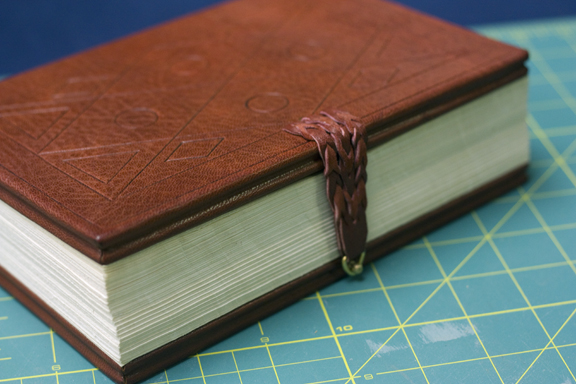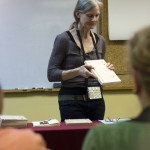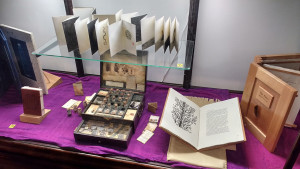This year, the Guild’s Standards of Excellence were held in sunny Tucson, Arizona. I landed Thursday afternoon, and after getting settled, cruised through the vendor rooms to peek at the weekend’s prospects. In the evening, we had a reception at the University of Arizona’s Special Collections library. There, we were able to see a great selection of their collection. We were also treated to a reception where everyone had a chance to catch up with one another.
Friday began the first day of demonstrations and I was eager to get started. My first session was with Martha Little who spoke about “Book Forensics†and how to find meaning in the evidence we find when examining and sometimes dismantling a book for repair or treatment. She exhibited great examples from old structures with very little of the book left behind to various bindings that had only a glimpse under the covering material. Some of these things were familiar and a great refresher course, while the rest was an “ah-ha!†or “oh yeah!†kind of realization. I learned a good deal from the presentation.
The afternoon’s session was with Michael Burke demonstrating the process of a Byzantine binding. I took notes and photos as often as possible so that I might try this one on my own. Hopefully, I’ve collected enough to try, but below are a few of my photos from the session. Beginning with the shaped wooden boards, Michael walked us through the channeling on the edges and how to drill the holes for attaching the boards, sewing the end bands and finally for the braided cord. One of the things that make this structure unique is that it is sewn in two halves, and then tied together at the center of those halves; most commonly a book is sewn from board to board.
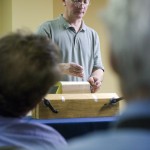
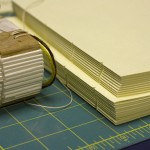
After the book block is assembled, the end bands were sewn with two cords at each end of the book followed by the attachment of leather. The cover can be blind tooled, as Michael’s example shows, then fixed with a closure. We were shown how to create the braided clasp and pin utilizing a brass screw and a piece of brass chain. When complete, the resulting book is beautiful, elegant and sturdy but also true to its historical origins.
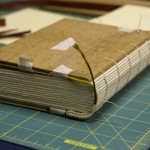
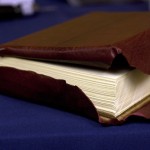
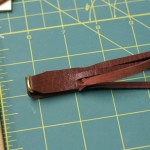
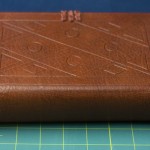
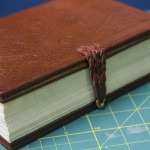
I mentioned the vendor rooms once already, but it is definitely one of the exciting parts of Standards. In the vendor rooms, one gets the rare opportunity to talk one on one with the people behind the stores so that any questions about materials and tools can be answered. And did I mention that you can peruse, perhaps buy, the wares brought by each vendor? You can find a list of people who were there at the Guild website.
Saturday was a full day. We had two more sessions to attend, the vendor rooms closing that afternoon (last chance to buy!), and the banquet/auction was also that evening. I began my morning with a memorable and wonderful presentation by Nancy Leavitt. Nancy gave everyone a wonderfully in depth view into the “joys and challenges of creating a book.â€Â She not only walked us through her processes, but she literally opened her notes to us allowing a glimpse of the real creation of her stunning books.
Nancy uses calligraphy in her books as well as a striking palette of color in her one-of-a-kind bindings. It is hard to use words to describe her work, so instead I will just show the photos. I will say, however, that after her presentation, Nancy left me with a seemingly endless supply of tools and methods that I will employ when creating my own work.
(Notice I use the word “sketch” but that is a word that came from Nancy. Each one is beautiful on its own yet they are just her tests of color and form on paper)
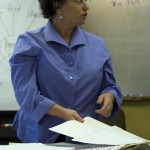
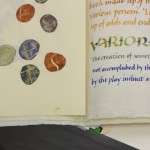
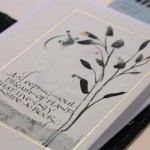
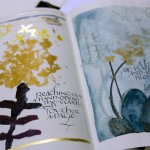
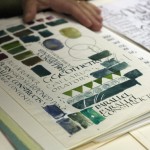
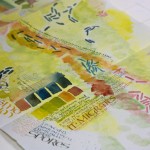
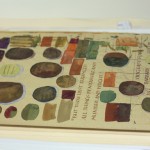
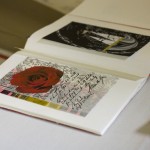
Much to the curiosity of the other participants throughout the weekend, my second session of the day shed light on the pounding noise that was heard throughout the other presentation. The noise was Jeff Peachy’s demonstration of late 18th century French binding structures. Rich with history, these books share unique qualities. One of these qualities was the noisily beaten paper. Jeff provided many sources for participants to refer to as well as many diagrams to explain the methods he introduced. A lively discussion was had between Jeff and the rest of the session’s participants making for a highly enjoyable discourse. One of my highlights of the presentation was when Jeff demonstrated the sharpening of a French paring knife…I had become the owner of such a knife in the vendor room just the day before!
With not too much time to wait, the bar opened and auction items were admired at the start of the banquet. Everyone was reunited again to enjoy the evening ahead. A good dinner and a highly entertaining auction later, I returned to my room a bit tired. I had a great time and my mind was full of things I wanted to try as soon as I returned home.
It is easy to see so many great things in a short amount of time as one weekend and feel like you can come up with enough ideas to last a year. Ultimately a greater feeling pervades. There is so much to learn about book binding and the book world in general. And the hardest lesson for me is that it will take time…a lot of time. There is no getting around it. Everyone I had the privilege of talking to was a reminder of that. No matter the desire to run before walking, it is clear that a LOT of experience must be gained before “great works†can be produced. This can at first seem daunting, but after thinking it over, it is a source of encouragement that I intend to draw from in the coming years.
